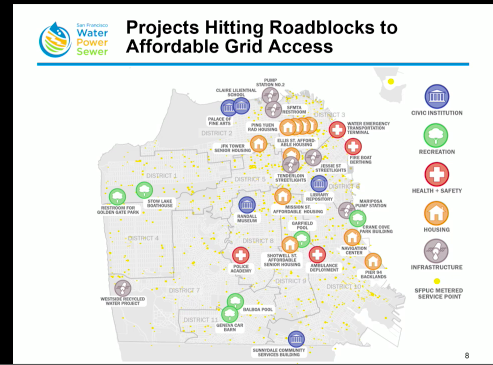
Toward the end of a hearing last week on how PG&E is delaying public projects, including affordable housing,by imposing unreasonable connection demands, Sup. Aaron Peskin did something city officials should have done years ago:
He told PG&E to stop messing with San Francisco – or the city will start moving to create its own retail public-power utility and in essence kick the private company out of town.

He couched in the way Peskin likes to do: “I don’t want to go back to the days of pitched warfare between the city and PG&E,” he said. “But I want to send a message to the [company] leadership: I don’t want to be put in a position to go back to those days.
“You can work it out [with the city]. You should do it expeditiously.”
Then Peskin mentioned Prop. A, the sleeper ballot measure that passed overwhelmingly June 5 and will allow the city to issue revenue bonds for clean power facilities.
That could include building a connection from Newark, where the city’s power lines end,across the Bay and up the Peninsula so that the city could sell power directly, without using PG&E at all. The city owns plenty of right-of-way along the route.
“This is the ominous threat, if you will,” Peskin said. “We now have the ability to build that infrastructure.”
If Jess Brown, director of the San Francisco Division of PG&E, got that message, and we will see this issue resolved fairly quickly. If not, and the company keeps trying to make it harder for the city to bring its own clean hydropower to customers, we may see a new effort to quickly build out the city’s own power system.
That, of course, is what Congress intended when it passed the Raker Act in 1913, giving San Francisco the right to build a dam for water in a national park (Yosemite) – but only if the dam also generated hydro power that would be used for a public power system in San Francisco. The Congressional record shows very clearly that environmentalists, who opposed the dam, only agreed to compromise with the city if the final outcome was to ensure that control of the Northern California electric grid was in the hands of the public, not a private utility.
PG&E has spent millions year after year to try to block public-power efforts – but with the multibillion-dollar liability from the North Bay fires, the company isn’t in the position to fight a major battle in its home town right now.
The hearing, called by Sup. Hillary Ronen, focused on the way PG&E has made it difficult for projects that get Hetch Hetchy power from the city to get connected to the grid.
“The more I look into this, the more appalled I am,” Ronen said.
In a long list of projects, PG&E initially said it would hook up the power in a routine way, requiring only the normal amount of basic equipment. But once the company learned that the city would be delivering the power, the rules changed: The utility demanded that every project have the sort of large, expensive equipment normally used only for facilities with huge power loads (like SF General).
In one case, the company wanted to the city to build a 750 square food transformer station, at the cost of more than $500,000, to serve a one-stall bathroom for Muni drivers.
The renovation of the Randall Museum took an extra year and cost an additional $840,000 because of PG&E’s demands. The renovation of Balboa Park Pool took an extra 13 months and cost and extra $800,000.
The same goes for affordable housing projects, which have been delayed and gone over budget because of PG&E.
This is all happening because the private utility wants to make it harder for the city to serve its own customers. Under the current arrangement, the city provides power to public agencies (Muni, the school district, City Hall, Rec-Park etc.) and, increasingly, to other customers that include affordable housing projects.
Then the city’s CleanPowerSF program offers residents and businesses the chance to buy 100 percent renewable power.
PG&E has consistently interfered with CleanPowerSF and uses every tool at its disposal to protect its illegal private-power monopoly. This is just the latest example.
Brown as much as admitted that during his testimony. He said that the MTA bathroom was just a “miscommunication” but that overall, the company requires expensive, “primary” electrical systems, even in small buildings, for anyone who is a wholesale customer. The same building, owned and operated by a retail customer (paying PG&E’s rates, which are way higher than what the city charges) would only be required to install “secondary” equipment.
“This is not about safety or energy needs,” Ronen said. “We are getting huge delays in project that could affect the lives and deaths of our residents. It’s not only outrageous but I would say criminal.”
This is a bad time for PG&E to pick a fight with San Francisco. If the company doesn’t back down, it could be exactly the motivation the supes need to put a complete public power system back on the agenda.
The key element: The PUC has to be willing to go up against PG&E. At the hearing, Harlan Kelly, the general manager, said he wasn’t interested in expansion beyond a modest number of new customers. That’s a terrible sign.
Two of the five commissioners have terms that end in August, 2018. One of the members, Francesca Vietor, has been a supporter of clean public power. One of the early signs of the direction of the Breed Administration will come when she decides whether her appointees to this key panel are going to be on the side of the public, and against PG&E.

